

Table of contents
- Year-round flowering hardy plants from A to F
- From G to K
- From M to P
- From R to S
- frequently asked Questions
With plants that bloom all year round, you can quickly create an attractive garden that does not require much maintenance, as long as the plants are also hardy. In this post, we will introduce you to 20 plants that are suitable for this.
Year-round flowering hardy plants from A to F
astilbe (Astilbe)

Source: Dinkum, Astilbe japonica 'Red Sentinel', Edited by Home Garden, CC BY-SA 3.0
Astilbes, too splendor spars called, are particularly well suited for shady, damp locations. They can even be used to plant pond edges.
- Growth height: up to 100 cm
- Location: semi-shady to shady, the sunnier, the wetter
- Care: remove faded flowers in spring and fertilize, divide if necessary
- Flowering period: June to September
- Flower color: white, yellow, pink, violet
- Varieties: Arendsii hybrids 'Glut', 'Bridal Veil', Japonica hybrids 'Red Sentinel', 'Peach Blossom'
bush mallow (Lavatera olbia)

The bush mallow can be cultivated both in the bed and in the bucket. However, it is not hardy in a pot.
- Growth height: up to 400 cm
- Location: sunny to semi-shady, sheltered from the wind, without special soil requirements
- Care: water regularly
- Flowering period: July to October
- Flower color: pink, white
- Varieties: 'Bredon Springs', 'Rosea', 'Barnsley'
scent nettle (Agastache)

The scented nettle not only convinces with a large selection of species and varieties, it also has a high attraction to insects and is therefore suitable for a natural garden.
- Growth height: up to 250 cm
- Location: sunny and rather dry
- Care: easy to care for, if self-sowing is undesirable, cut back after flowering
- Flowering period: June to September
- Flower color: blue, violet, orange, white, greenish
- Species: Blue nettle (Agastache rugosa), aniseed hyssop (Agastache foeniculum), false nettle (Agastache urticifolia), lime hyssop (Agastache mexicana)
speedwell (Veronica)
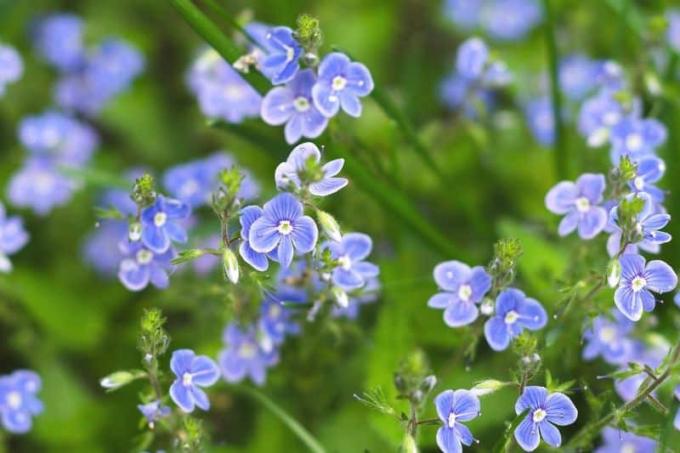
speedwell not only grows wild in meadows. There are some species that are of horticultural importance and perennial beds beautify.
- Growth height: up to 40 cm
- Location: sunny to semi-shady, dry to moist soil depending on the species
- Care: easy care
- Flowering period: May to September
- Flower color: blue, violet, pink, white, red
- Species: Brook speedwell (Veronica beccabunga), Ivy-leaf speedwell (Veronica hederifolia)
Dyer's dog chamomile (Anthemis tinctoria)
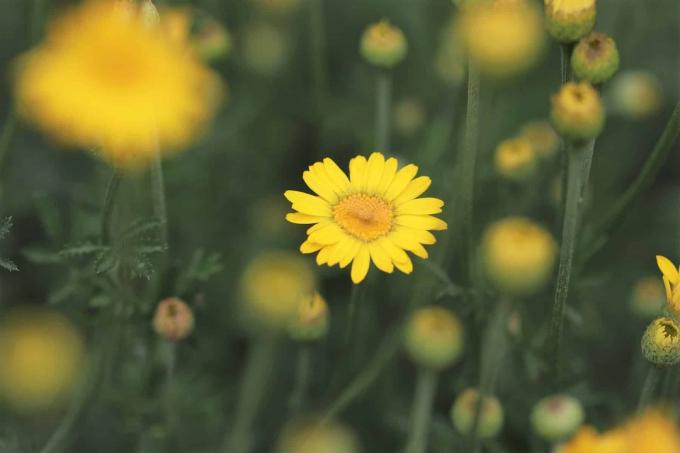
The yellow dyer's dog chamomile likes to sow itself, provided that the location suits it. It is very popular with insects.
- Growth height: up to 60 cm
- Location: sunny, dry, nutrient-poor soil
- Care: easy care
- Flowering period: June to September
- Flower color: yellow, creamy white
- Varieties: 'Kelwayi', 'Grallagh Gold', 'Ala Dagh'
hosts (Hosta)

hosts are very suitable for cooler and darker areas of the garden, where they can grow undisturbed and spread over large areas.
- Growth height: up to 50 cm
- Location: cool, partially shaded to shaded, moist soil
- Care: water when dry
- Flowering period: June to September
- Flower color: white, purple
- Species: White-leafed hosta (Hosta sieboldii), Blue-leafed hosta (Hosta sieboldiana), Grey-leafed hosta (Hosta fortunei)
From G to K
daisy (Bellis perennis)
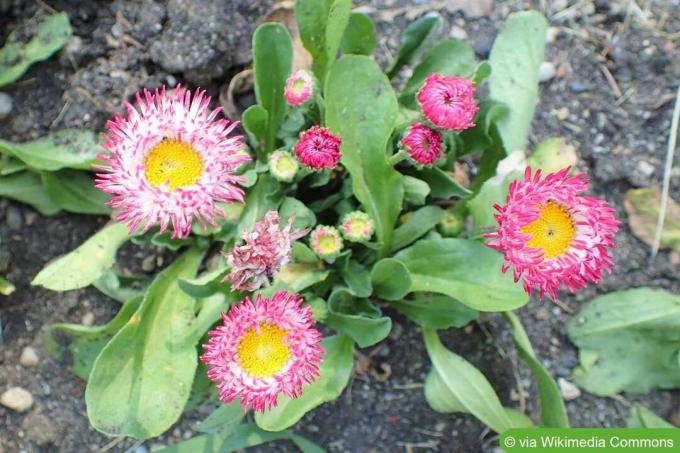
Source: Krzysztof Ziarnek, Kenraiz, Bellis perennis 'Habanera White with Red Tips' kz01, Edited by Home Garden, CC BY-SA 4.0
The daisy is known as a native wild plant. However, there are also some varieties of the hardy plant that are cultivated in gardens.
- Growth height: up to 15 cm
- Location: as sunny and dry as possible
- Care: easy care
- Flowering time: possible all year round
- Flower color: pink, white
- Varieties: 'Habanera', 'Floro pleno', 'Pomponette red'
Horned Violet (Viola cornuta)

At Horned Violet these are not the classic ones pansies. Horned violets are slightly smaller.
- Characteristics: up to 20 cm high, short-lived perennial
- Location: sunny to semi-shady, nutrient-rich, loose, well-drained soil
- Care: water regularly
- Flowering time: March to October
- Flower color: many colors
- Varieties: 'Blackjack', 'Ruby', 'Winona'
Tip:
In addition to the 'pure' horned violet varieties, there are also hybrids between horned violets and pansies.
icelandic poppy (Papaver nudicaule)
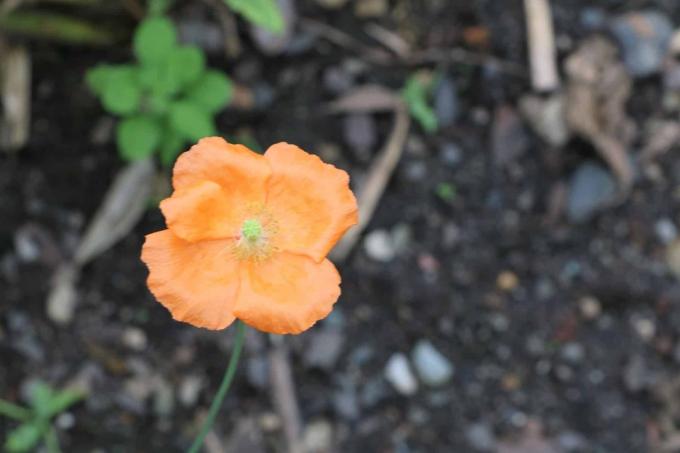
Most of the time he will icelandic poppy only cultivated for one or two years, but it can survive in the garden for several years and likes to self-seed.
- Growth height: up to 50 cm
- Location: sunny to semi-shady, well-drained, not too nutrient-rich soil
- Care: easy to care for, water only when dry
- Flowering period: May to August
- Flower color: white, yellow, orange, red
- Varieties: 'Magnificent Mixture', 'Matador'
catnip (Nepeta)
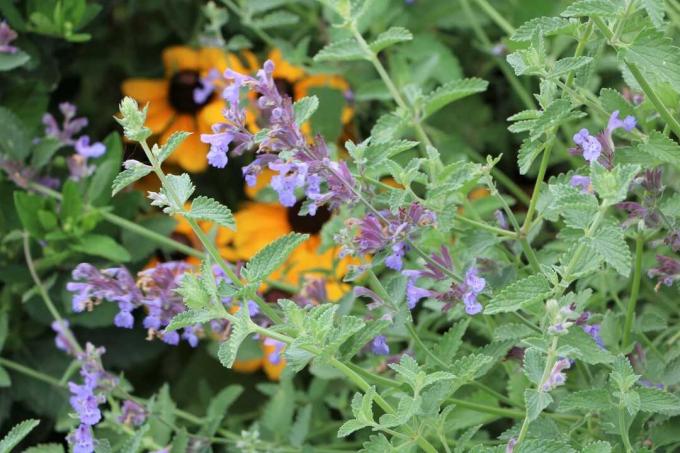
If the catnip after a few years it flowers less, it's time to stimulate it to produce new blooms by dividing it.
- Growth height: up to 140 cm
- Location: sunny and rather dry, well-drained soil
- Care: water only when dry
- Flowering time: April to July
- Flower color: violet, blue
- Species: Bluemint (Nepeta x faassenii), Large-flowered catnip (Nepeta grandiflora), Catnip (Nepeta cataria)
Tip:
If you cut back the catnip after the first bloom, it will sometimes bloom a second time a year.
blanket flower (Gaillardia)

Blanket flower is a short-lived perennial that only grows in the garden for a few years.
- Growth height: up to 80 cm
- Location: sunny and dry, sandy to stony soil
- Care: only water for waxing, later keep mostly dry
- Flowering period: July to October
- Flower color: multicolored with yellow, orange and red
- Species: Large-flowered Blanket Flower (Gaillardia x grandiflora), Prairie Blanket Flower (Gaillardia aristata)
From M to P
girl eye (coreopsis)

That too girl eye is one of the rather short-lived perennials that are often only cultivated as an annual. In principle, however, the perennial is hardy.
- Growth height: up to 80 cm
- Location: sunny, well-drained, nutrient-rich, loose soil
- Care: water from time to time, support long-stemmed varieties
- Flowering period: June to October
- Flower color: in all yellow variations
- Species: Lanceolate Tickseed (Coreopsis lanceolata), Large-flowered Tickseed (Coreopsis grandiflora)
clove root (geum urbanum)

The avens is a native wild perennial that is often cultivated in gardens. The hardy plant that blooms all year round usually sows itself.
- Growth height: up to 80 cm
- Location: sunny to semi-shady, not too dry, well-drained, nutrient-rich soil
- Care: easy care
- Flowering period: May to October
- Flower color: yellow
A notice:
The rootstocks in the ground give the plant its name and they smell like cloves.
ox eye (Buphthalmum salicifolium)
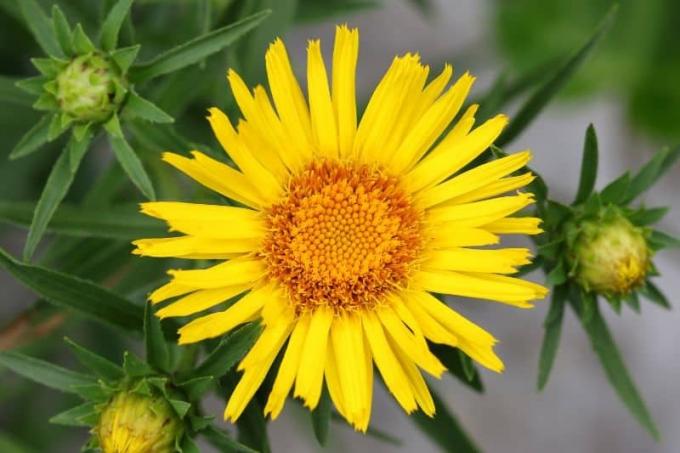
The oxeye hardly makes any demands on the soil, it even grows well in nutrient-poor soil and forms dense cushions.
- Growth height: up to 60 cm
- Location: sunny to semi-shady, without special soil requirements
- Care: easy care
- Flowering period: June to October
- Flower color: yellow
- Varieties: 'Alpengold'
PatagonianVerbena (Verbena bonariensis)

Since it is not always sufficiently hardy, this requires Verbena in the cold season a shelter of leaves or brushwood. But it also likes to self-seed and stays in the garden.
- Growth height: up to 200 cm
- Location: sunny, soil not too dry and rich in nutrients
- Care: easy to care for, get rid of weeds around the plant
- Flowering period: July to October
- Flower color: violet
- Varieties: 'Purple Tower'
splendor candle (Gaura lindheimeri)
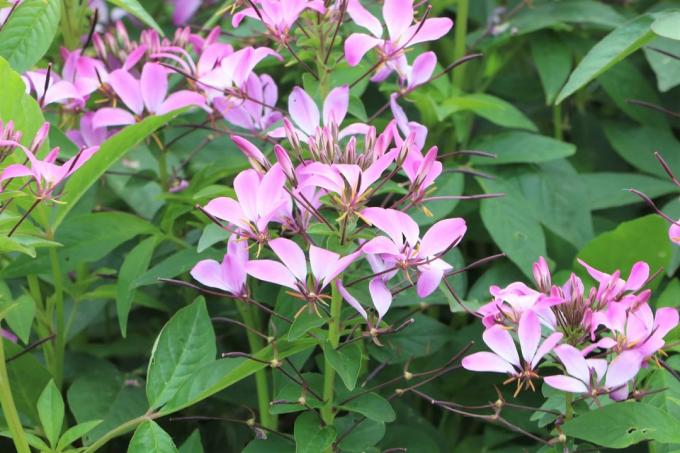
The splendor candle belongs to the evening primrose family. The flower spikes of this perennial, also known as prairie candle, can reach a length of more than 50 cm.
- Growth height: up to 150 cm
- Location: sunny, well-drained, loose, sandy soil
- Care: easy care
- Flowering period: June to September
- Flower color: white, pink
- Varieties: 'Corrie's Gold', 'Summer Breeze'
Purple Scabious (Knautia macedonica)

The purple scabious blooms in a strong red. The perennial should be divided after a few years, this promotes flowering.
- Growth height: up to 100 cm
- Site: sunny, sandy, well-drained soil that is not too nutrient-rich
- Care: Water when dry
- Flowering period: July to September
- Flower color: red
- Varieties: 'Melton Pastels', 'Mars Midget'
From R to S
Red Coneflower (Echinacea purpurea)
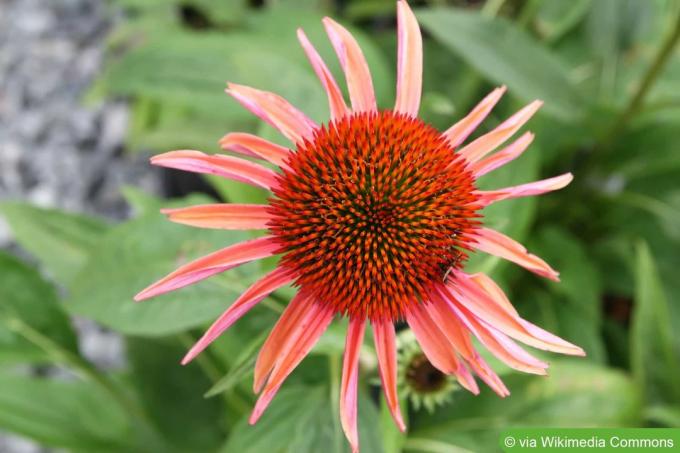
Source: Photo by David J. pole, Echinacea Sunset 2zz, Edited by Home Garden, CC BY-SA 4.0
her too purple coneflower This perennial should be divided after a few years so that it can sprout vigorously again and remain floriferous.
- Growth height: up to 100 cm
- Location: sunny to semi-shady, well-drained, nutrient-rich soil
- Care: easy care
- Flowering period: July to September
- Flower color: white, yellow, orange, red, also multicolored
- Varieties: 'Milkshake', 'Sunset', 'Green Envy'
A notice:
The coneflower is also cultivated as a medicinal plant.
yarrow (Achillea millefolium)

Source: Photo by David J. pole, Achillea Terracotta 2zz, Edited by Home Garden, CC BY-SA 4.0
As a native plant, the yarrow completely hardy. In addition, the plant requires little care.
- Growth height: up to 60 cm
- Location: sunny, without special soil requirements
- Care: easy to care for, water when it is very dry
- Flowering period: June to October
- Flower color: white, yellow, reddish, orange
- Varieties: 'Tricolor', 'Petra', 'Terracotta'
marsh yarrow (Achillea ptarmica)

The plant, also called Bertram's sheaf, looks very similar to the yarrow presented above, but has no pinnate leaves. It forms numerous flowers throughout the summer.
- Growth height: up to 100 cm
- Location: sunny, soil not too dry
- Care: easy to care for, likes to spread by itself
- Flowering period: July to October
- Flower color: white
- Varieties: 'Snowball', 'Nana Compacta', 'Peter Cottontail'
frequently asked Questions
Plants that flower continuously or many months in a row use up a lot of nutrients. It is therefore important to fertilize them regularly, especially if they are cultivated in pots or tubs. Then a flowering plant fertilizer is best suited. In the bed, the gift of compost in combination with a mulch layer.
To ensure that the flowers keep producing new blossoms, it makes the most sense to regularly remove faded flowers. Depending on the growth of the plant, it is important not to cut away any new buds.
Hardy does not always mean frost-resistant under all circumstances. A layer of leaves under perennials protects the roots, and you should also pay attention to the right location. Too much moisture can negatively affect winter hardiness because the roots rot in winter.
 Mirko
Mirko
Learn more about perennials

17 flowering hardy plants May to October
Many plants only show their full splendor for a short time. But there are also types and varieties with a particularly long flowering period from May to October, sometimes even longer. We present 17 flowering hardy plants.

Hardy perennials: 22 perennial bloomers
Hardy perennials as permanent bloomers in the flower bed enchant the garden from early summer to autumn with a colorful bloom. They are easy to care for and magically attract butterflies, bees and the like.

10 care tips for the banana tree
If you like it exotic, cultivate a banana tree as a houseplant or in the conservatory. In summer, the banana plants are even allowed outside for a few weeks. The large leaves that the Musa forms on a false trunk are particularly decorative and impressive, and therefore look like a small tree.

Properly care for globe thistle | 10 tips for care
The globe thistle is an eye-catcher in the garden. Their spherical flowers provide a food source for insects. The globe thistle is not difficult to care for and it is suitable for dry locations. With a few tips on care, the plants will develop even better.
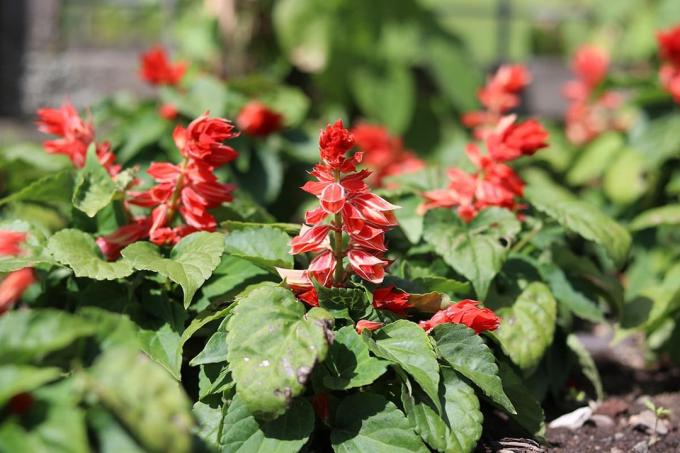
Fire sage, Salvia splendens: care from A to Z
Fire sage is known in botanical jargon as Salvia splendens and is a particularly decorative eye-catcher. But what kind of care does the plant need? Our guide to the salvia shows the important points from A to Z.
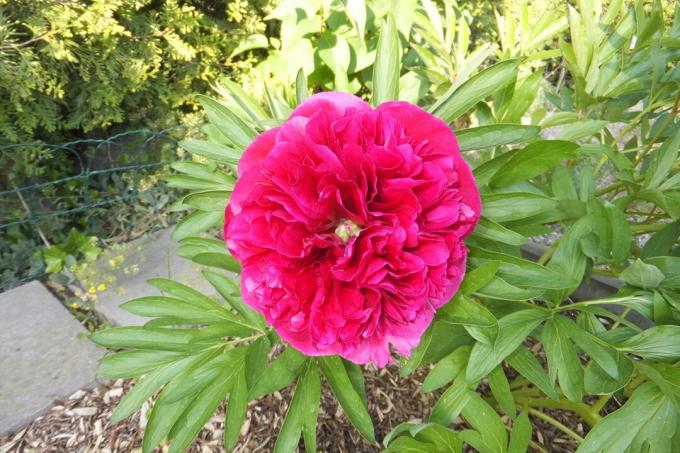
Peonies, Paeonia: 11 tips for care
Peonies enchant with their extremely decorative flowers, which draw everyone's attention. In order for the flowers to be particularly lush and to last for a long time, care must be taken accordingly. Our tips show how the Paeonia thrives best.
